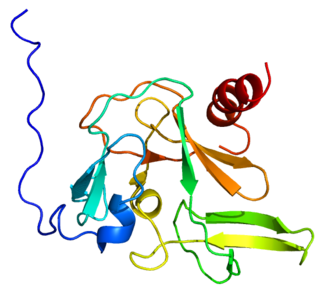
The "C" sub-family of chemokine receptors contains only one member: XCR1, the receptor for XCL1 and XCL2.

Tripartite motif-containing 28 (TRIM28), also known as transcriptional intermediary factor 1β (TIF1β) and KAP1, is a protein that in humans is encoded by the TRIM28 gene.

PR domain zinc finger protein 2 is a protein that in humans is encoded by the PRDM2 gene.

Zinc finger homeobox protein 3 is a protein that in humans is encoded by the ZFHX3 gene.

Krueppel-like factor 10 is a protein that in humans is encoded by the KLF10 gene.

Breast cancer anti-estrogen resistance protein 3 is a protein that in humans is encoded by the BCAR3 gene.

Zinc transporter SLC39A7 (ZIP7), also known as solute carrier family 39 member 7, is a protein that in humans is encoded by the SLC39A7 gene. Its fruit fly orthologue is Catsup.

Early growth response protein 3 is a protein in humans, encoded by the EGR3 gene.

Zinc finger protein 274 is a protein that in humans is encoded by the ZNF274 gene.

Zinc finger protein 219 is a protein that in humans is encoded by the ZNF219 gene.

Protein Jade-3 is a protein that in humans is encoded by the PHF16 gene.

Zinc finger protein 267 is a protein that in humans is encoded by the ZNF267 gene.

Tripartite motif-containing protein 16 is a protein that in humans is encoded by the TRIM16 gene.

Zinc transporter ZIP6 is a protein that in humans is encoded by the SLC39A6 gene.

Breast carcinoma amplified sequence 3, also known as BCAS3, is a protein which in humans is encoded by the BCAS3 gene. BCAS3 is a gene that is amplified and overexpressed in breast cancer cells.

Cip1-interacting zinc finger protein is a protein that in humans is encoded by the CIZ1 gene.

RING finger protein 115 is a protein, that in humans, is encoded by the RNF115 gene.

Zinc finger protein 160 is a protein that, in humans, is encoded by the ZNF160 gene.

Zinc finger, X-linked, duplicated family member C (ZXDC) is a human CIITA-binding protein involved in the activation of major histocompatibility complex (MHC) class I and II. For binding to occur, ZXDC must form an oligomeric complex with another copy of itself or with ZXDA, a related protein. ZXDC is activated by sumoylation, a post-translational modification. ZXDC plays a role in controlling immunological responses, cancer formation and progression, and cell proliferation, differentiation, and survival.

C8orf48 is a protein that in humans is encoded by the C8orf48 gene. C8orf48 is a nuclear protein specifically predicted to be located in the nuclear lamina. C8orf48 has been found to interact with proteins that are involved in the regulation of various cellular responses like gene expression, protein secretion, cell proliferation, and inflammatory responses. This protein has been linked to breast cancer and papillary thyroid carcinoma.


















